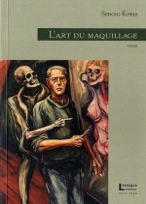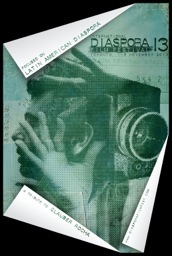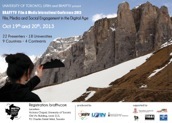Hudson Moura
Activities
1. call for papers
The Becoming of Archival Images in Documentary Filmmaking Seminar (NeMLA, Toronto 2015)
Chairs: Hudson Moura (UofT), Marta Marin-Domine (UWL)
Archiving is in itself a gesture of the present caring about a past that one wishes to project into the future, or as Jacques Derrida puts it, a token of the future. However, contemporary cinema is marked by a new approach to the archive, most specifically to the circulation of archival images inserted in documentary films, through their materialization that implies the coexistence of at least three different modalities of appropriation: a) the canonical one that searches in these images the referent of past historical events; b) the use of archival images to fictionalize memorial narratives; and, c) the creation of false archival images to underline the tension between fiction and truth. Parallel to these trends in documentary filmmaking, the 21st century created the new phenomenon of ‘digital storages’ by the constant production of images that are instantly part of a virtual archive which aim is not necessarily that of becoming a “token of the future”, a trace of what it has been, but a storage of what constantly “is”: a huge global wasteland of images that are the result of multiple purposes that span from surveillance (CCTV) to the instant demand of global communication or the narcissistic inscription of oneself in the constant flow of the present. How do archives contribute to the invention of the past? What do archival images add to documentary filmmaking in terms of their value as “true” documents? When a documentary becomes an archive itself? This Seminar seeks to elicit the debate around the use of this quasi-infinite repository of images (digital storages) in documentary filmmaking (circulation, appropriation, creation of new meanings) as well as to open the possibility to reflect on the appropriation of the “archive” as a genre (the mimicking of the archives’ aesthetics) and its ethical implications. Send us a 300 words proposal by September 15.
2. Talks
Click here to access some abstracts and talks
3. upcoming talks
Colloque International Cartographies littéraires du Brésil actuel : espaces, acteurs et mouvements sociaux dans le cadre de la Semaine « Rencontres Internationales - Brésil » que l'Université Rennes 2 réalisera en novembre 2014.
Ma communication, intitulée « Le récit déplacé dans la littérature brésilienne », analyse les transformations narratives dans la littérature brésilienne à travers l’expérience du déplacement – déplacement réel de l’écrivain ou fictionnel des personnages. Qu’est-ce que cela engendre dans le récit ? Quelle influence le déplacement exerce t-il dans l’écriture ? Un nombre important d’écrivains brésiliens (Chico Buarque, Bernardo Carvalho, Sergio Kokis, Silviano Santiago, Milton Hatoum, entre autres) ont recours à la figure de l’étranger pour délivrer leurs histoires et se pencher sur l’écriture elle-même, relevant non seulement la dichotomie entre étranger et local, mais aussi le déplacement. Ces écrivains s’engagent dans une entreprise personnelle sur l’acte de l’écriture et ses impossibilités, comme dirait Maurice Blanchot. L’expérience du déplacement ne résulte pas dans l'impuissance de l’acte narratif, au contraire, il génère une prolifération de nouveaux récits. L’idée centrale est que les changements de vision et de conception du monde vécu par l’individu déplacé créent une idée tout autant d’un monde en devenir qu’ouvert aux multiples horizons. Le monde est finalement affecté et transformé par le regard et la perception de l’individu déplacé et par l’écriture « étrangère ».
4. Upcoming events
INTERACTIVE NARRATIVES, NEW MEDIA AND SOCIAL ENGAGEMENT
OCTOBER 24-25, 2014
Victoria College, University of Toronto, Canada
An interdisciplinary conference for researchers and practitioners.
How has the digital screen changed our world in general and narrative and visual arts in particular is the broad focus of the second Department of Spanish and Portuguese at the University of Toronto and BRAFFTV Film and Media international Conference. We are interested, for instance, in the evolution of narrative practices from text-based literature to the advent of the digital revolution as storytelling moves from literacy to so-called post-literacy.
The prevalence of new interactive digital narrative in all areas from games, to literature, to films, to video art has resulted in new forms of storytelling and, accordingly, provoked new practices of reading that transforms readers/viewers into active collaborators. We are interested in exploring transmedia, intermediality, the role of social media and digital globalization as well as narratives in games and graphic novels. Also, the impact of the digital screen on art and new exhibition practices.
Physical public space is increasingly being substituted or augmented by virtual space through digital screens (e.g. video, film, computer). What effect do these new developments have on social space, seen here as encompassing both physical public spaces (streets, hotels, coffee shops) as well as virtual space (YouTube, Vine, Facebook, Twitter, Tumblr, Orkut, etc.)? How do these novel practices effect previously clearly demarcated frontiers between the public and the private? Throughout the world, from Brazil to Turkey to Canada, we have recently witness the influence of social media on political participation. How have these new platforms engendered innovative forms of expression?
Organizing Committee
Hudson Moura (Chair), Ricardo Sternberg (University of Toronto), Sonia Regina da Cunha Soares (Universidade do Minho, Portugal) and Cecília Queiroz (BRAFFTV)
5. past events
BRAFFTV Film & Media International Conference: Film, Media and Social Engagement in the Digital Age
18-20 October, 2013
Victoria College, University of Toronto
The conference discussions will be focused on film, media and social engagement in the digital age. The goal is to propose a broad debate, emphasizing the need to evaluate the increasing use of digital screens in contemporary society and how people and countries are dealing with their own image, identity and digital cultural space artistically, socially and politically. Film and media practitioners and educators have been expanding the use of digital media through new experiences with unusual and innovative technical and artistic approaches. At the same time, researchers and academics are questioning and analyzing these new practices, which are increasingly dominating global society.
The way in which people and countries are dealing with the advent of new technologies reflects social issues and makes us deepen the debate on matters such as our own identity and the state of research conducted in these countries.
How are countries acting in face of these new phenomena? Does globalization standardize the use of new media? How are the countries reacting?
Organizing Committee
Ricardo Sternberg (University of Toronto), Hudson Moura (University of Toronto), Sonia Regina da Cunha Soares (Universidade do Rio Grande do Norte) and Cecília Queiroz (BRAFFTV)
Tribute to glauber rocha
The International Diaspora Film Festival of Toronto presented a rare opportunity to screen two recently restored films by celebrated Brazilian film director Glauber Rocha, a key figure in the Brazilian Cinema Novo movement who influenced filmmakers internationally with his innovative style and his socially and politically conscious films which challenged the status quo. The FREE screening of the highly acclaimed and ground breaking film Antonio Das Mortes on Tuesday November 5, at 7 pm, at the Innis Town Hall was followed by a panel discussion on the cinema of Glauber Rocha and his contribution to World Cinema, moderated by Professor Brian Damude (Ryerson University) and included Rocha scholar Hudson Moura (University of Toronto), Professor Eva-Lynn Jagoe (University of Toronto) and Afonso Cardoso, the Consul General of Brazil in Toronto.
6. Links
When do images become archives? What does mean archive for films? How do films re-appropriate archive images?





